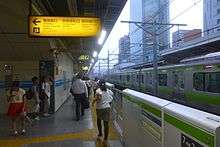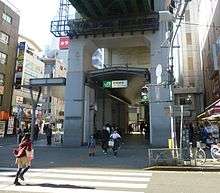Akihabara Station
Coordinates: 35°41′54″N 139°46′25″E / 35.698240°N 139.773731°E
Akihabara Station 秋葉原駅 | |
|---|---|
 The Akihabara Electric Town entrance of Akihabara Station, February 2015 | |
| Location |
1 Soto-Kanda (JR Station) Kanda-Sakuma-chō (Tokyo Metro) Kanda-Hanaoka-chō (Tsukuba Express) Chiyoda, Tokyo Japan |
| Operated by | |
| Line(s) | |
| Connections | Bus terminal |
| History | |
| Opened | 1890 |
| Location | |
 Akihabara Station Location within Japan | |
Akihabara Station (秋葉原駅 Akihabara-eki) is a railway station in Tokyo's Chiyoda ward. It is at the center of the Akihabara shopping district specializing in electronic goods.
Lines
Akihabara Station is served by the following lines. JR East:
Metropolitan Intercity Railway Company:
The above-ground section of the station is cross-shaped, with the Chūō-Sōbu Line tracks running from east to west, and the Yamanote and Keihin-Tohoku Line (and Tohoku Shinkansen, which does not stop at Akihabara) from north to south.
Station layout


JR East
There are two island platforms serving four tracks for the Yamanote Line and the Keihin-Tohoku Line on the 2nd level, and two side platforms serving two tracks for the Sobu Line Local service on the 4th level.
| 1 | ■ Keihin-Tohoku Line | northbound for Ueno, Tabata, and Ōmiya |
| 2 | ■ Yamanote Line | anti-clockwise for Ueno, Tabata, and Ikebukuro |
| 3 | ■ Yamanote Line | clockwise for Tokyo, Shinagawa, and Shibuya |
| 4 | ■ Keihin-Tohoku Line | southbound for Tokyo, Shinagawa, and Yokohama |
| 5 | ■ Chūō-Sōbu Line | westbound for Ochanomizu, Shinjuku, Nakano, and Mitaka |
| 6 | ■ Chūō-Sōbu Line | eastbound for Kinshichō, Funabashi, and Chiba |
Chest-high platform edge doors were installed on the Yamanote Line platforms in May 2015, to be brought into operation from 20 June 2015.[1]
Tokyo Metro

There are two underground side platforms serving two tracks.
| 1 | ○ Tokyo Metro Hibiya Line | for Ginza, Kasumigaseki, and Naka-Meguro |
| 2 | ○ Tokyo Metro Hibiya Line | for Ueno, Kita-Senju |
The song "Koi Suru Fortune Cookie" by AKB48 is to be used as the departure melody on the Hibiya Line platforms from spring 2016.[2]
Tsukuba Express
There is an underground island platform serving two tracks.
| G | Street level | Exits/Entrances, connection to JR services |
| B1F | Upper Mezzanine | Fare control, station agent, ticket/Pasmo/Suica vending machines, FamilyMart, shopping, elevator to platform |
| B2F | Center Mezzanine | Staircases and escalators to Lower Mezzanine |
| B3F | Lower Mezzanine | Staircases and escalators to platform |
| B4F Platform level |
1 | TX Tsukuba Express towards Tsukuba (Shin-Okachimachi) → |
| 2 | TX Tsukuba Express towards Tsukuba (Shin-Okachimachi) → | |
| 1, 2 | ■ Tsukuba Express | for Minami-Nagareyama, Moriya, and Tsukuba |
Adjacent stations
| « | Service | » | ||
|---|---|---|---|---|
| Yamanote Line | ||||
| Kanda | - | Okachimachi | ||
| Keihin-Tohoku Line[3] | ||||
| Kanda | Rapid (weekdays) |
Ueno | ||
| Kanda | Rapid (weekends and national holidays) |
Okachimachi | ||
| Kanda | Local | Okachimachi | ||
| Chūō-Sōbu Line | ||||
| Asakusabashi | Local | Ochanomizu | ||
| Tokyo Metro Hibiya Line (H-15) | ||||
| Kodenmachō (H-14) | - | Naka-Okachimachi (H-16) | ||
| Tsukuba Express (01) | ||||
| Terminus | Rapid | Shin-Okachimachi (02) | ||
| Terminus | Commuter Rapid | Shin-Okachimachi (02) | ||
| Terminus | Semi Rapid | Shin-Okachimachi (02) | ||
| Terminus | Local | Shin-Okachimachi (02) | ||
History
Akihabara Station was opened in November 1890 as a freight terminal linked to Ueno Station via tracks following the course of the modern day Yamanote Line.
It was opened to passenger traffic in 1925 following the construction of the section of track linking Ueno with Shinbashi via Tokyo Station and the completion of the Yamanote Line. The upper level platforms were added in 1932 with the opening of an extension to the Sōbu Line from its old terminal at Ryōgoku to Ochanomizu, making Akihabara an important transfer station for passengers from the east of Tokyo and Chiba Prefecture.
The huge growth in commuter traffic following the Second World War caused considerable congestion and was only relieved with the construction of the Sōbu line tunnel linking Kinshichō with Tokyo, bypassing Akihabara.
The Hibiya Line subway station was opened on May 31, 1962 with the line's extension from Naka-Okachimachi to Ningyōchō.
On August 24, 2005, the underground terminus of the new Tsukuba Express Line opened at Akihabara. The entire station complex, including the JR station, was also refurbished and enlarged in preparation for the opening of the Tsukuba Express.[4]
Passenger statistics
In fiscal 2013, the JR East station was used by an average of 240,327 passengers daily (boarding passengers only), making it the ninth-busiest station operated by JR East.[5] Over the same fiscal year, the Tokyo Metro station was used by an average of 122,576 passengers daily (both exiting and entering passengers), making it the 23rd busiest Tokyo Metro station.[6]
The passenger figures for previous years are as shown below.
| Fiscal year | Daily average | ||
|---|---|---|---|
| JR East | Tokyo Metro | ||
| 2000 | 137,736[7] | ||
| 2005 | 171,166[8] | ||
| 2010 | 226,646[9] | ||
| 2011 | 230,689[10] | 119,184[11] | |
| 2012 | 234,187[12] | 119,409[13] | |
| 2013 | 240,327[5] | 122,576[6] | |
- Note that JR East figures are for boarding passengers only.
Surrounding area
The main attraction is the Akihabara electronics retail district to the north and west of the station.
Bus terminal
Route buses
- Cha 51(茶51); For Ochanomizu Station, Hongō-sanchōme Station, and Komagome Station[14]
- Aki 26(秋26); For Kanda Station, Iwamotochō Station, Kiyosumi-shirakawa Station, and Kasai Station[14]
- Kazaguruma Akihabara Route; For Ochanomizu Station, Chiyoda City Office[15]
- AKIBA SHUTTLE; For Tokyo Skytree, Asakusa Kaminarimon[16]
Highway buses
- My Town Direct Bus; For Tokyo Disney Resort, Shin-Urayasu Area[17]
- Airport Limousine; For Haneda Airport[18]
- Kanto Yakimono Liner; For Kasama Station, Mashiko Station[19]
- For Takasaki Station, Shin-Maebashi Station, Maebashi Station, and Maebashi Bus Center[20]
- Tono Kamaishi; For Shin-Hanamaki Station, Tōno Station, Kamaishi Station, Kirikiri, and Yamada[21]
- Yuhi; For Tsuruoka Station, Amarume Station, and Sakata Station[22]
- Southern Cross; For Kyōto Station, Ōsaka Station, Namba Station, and Osaka City Air Terminal(JR Namba Station)[23]
- Tokyo Tokkyu New Star; For Kyōto Station, Ōsaka Station, Universal Studios Japan, Tennōji Station, Ōsaka Uehommachi Station, and Fuse Station[24]
- For Toyama Station, Kanazawa Station, and Kenroku-en[20]
See also
References
- ↑ 山手線秋葉原駅に可動式ホーム柵設置 [Platform edge doors installed at Yamanote Line Akihabara Station]. Japan Railfan Magazine Online (in Japanese). Japan: Koyusha Co., Ltd. 23 May 2015. Retrieved 23 May 2015.
- ↑ 日比谷線 秋葉原駅・銀座駅、千代田線 乃木坂駅 発車メロディ導入曲決定! [Departure melodies to be introduced at Hibiya Line Akihabara and Ginza Stations and Chiyoda Line Nogizaka Station]. News release (in Japanese). Japan: Tokyo Metro. 20 January 2016. Retrieved 20 January 2016.
- ↑ "2015年3月 ダイヤ改正について" [Information regarding the March 2015 timetable amendment] (pdf). East Japan Railway Company. 19 December 2014. p. 10. Retrieved 16 April 2015.
- ↑ SeeJapan: August 2007
- 1 2 各駅の乗車人員 (2013年度) [Station passenger figures (Fiscal 2013)] (in Japanese). Japan: East Japan Railway Company. Retrieved 31 August 2014.
- 1 2 各駅の乗降人員ランキング [Station usage ranking] (in Japanese). Tokyo Metro. Retrieved 31 August 2014.
- ↑ 各駅の乗車人員 (2000年度) [Station passenger figures (Fiscal 2000)] (in Japanese). Japan: East Japan Railway Company. Retrieved 31 August 2014.
- ↑ 各駅の乗車人員 (2005年度) [Station passenger figures (Fiscal 2005)] (in Japanese). Japan: East Japan Railway Company. Retrieved 31 August 2014.
- ↑ 各駅の乗車人員 (2010年度) [Station passenger figures (Fiscal 2010)] (in Japanese). Japan: East Japan Railway Company. Retrieved 31 August 2014.
- ↑ 各駅の乗車人員 (2011年度) [Station passenger figures (Fiscal 2011)] (in Japanese). Japan: East Japan Railway Company. Retrieved 31 August 2014.
- ↑ 各駅の乗降人員ランキング [Station usage ranking] (in Japanese). Tokyo Metro. Retrieved 31 August 2014.
- ↑ 各駅の乗車人員 (2012年度) [Station passenger figures (Fiscal 2012)] (in Japanese). Japan: East Japan Railway Company. Retrieved 31 August 2014.
- ↑ 各駅の乗降人員ランキング [Station usage ranking] (in Japanese). Tokyo Metro. Retrieved 31 August 2014.
- 1 2 "系統運行状況/系統一覧選択 | 都バス運行情報サービス | 東京都交通局". tobus.jp (in Japanese). Retrieved 2016-01-24.
- ↑ 千代田区. "千代田区ホームページ - 地域福祉交通「風ぐるま」". www.city.chiyoda.lg.jp (in Japanese). Retrieved 2016-01-24.
- ↑ "AKIBA SHUTTLE(時刻表・料金・路線図) | タクシー予約・求人 日立自動車交通". www.hitachi-gr.com (in Japanese). Retrieved 2016-01-24.
- ↑ "「東京ディズニーリゾート®」・新浦安地区~秋葉原・東京駅 | 高速バス | 京成バス". www.keiseibus.co.jp (in Japanese). Retrieved 2016-01-24.
- ↑ "Mejiro,Kudan,Kourakuen,Akihabara - Haneda Airport | Scheduled Bus Services | Airport Limousine Bus". www.limousinebus.co.jp. Retrieved 2016-01-24.
- ↑ "関東やきものライナー : 益子・笠間 ─ 秋葉原駅 | 高速バスのご案内 - 茨城交通". www.ibako.co.jp (in Japanese). Retrieved 2016-01-24.
- 1 2 "日本中央バス 毎日運行!!高速バス". www.ncbbus.co.jp. Retrieved 2016-01-24.
- ↑ "高速バス 気仙沼・陸前高田・大船渡/遠野・釜石・大槌・山田 〔けせんライナー/遠野・釜石号〕 | 高速バス | 国際興業バス". 5931bus.com (in Japanese). Retrieved 2016-01-24.
- ↑ "高速バス 鶴岡・余目・酒田 [夕陽号] | 高速バス | 国際興業バス". 5931bus.com (in Japanese). Retrieved 2016-01-24.
- ↑ "南海バス|大阪・京都⇔秋葉原・成田空港・銚子". www.nankaibus.jp. Retrieved 2016-01-24.
- ↑ "東京特急ニュースター号|路線案内|高速・貸切バス 大阪バス株式会社". www.osakabus.jp. Retrieved 2016-01-24.
External links
| Wikimedia Commons has media related to Akihabara Station. |
- Akihabara Station information (JR East) (Japanese)
- Akihabara Station information (Tokyo Metro) (Japanese)
- Akihabara Station information (Tsukuba Express) (Japanese)
- Webcam with sound showing Northern side and tracks of Akihabara station (Japanese)